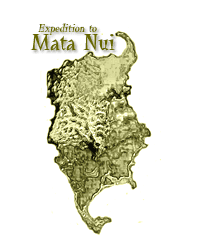

Island Recent History and Facts
 Intriguing cliff carving at Site 5 on Northeastern shoreline. The team's Land Rover provides a sense of scale. |
 |
 Island Recent History and Facts
|
|
Island Statistics
The native peoples of Rapa Nui have apparently visited their larger sister island numerous times, and several local legends have grown around those visits. Chief among those legends are the descriptions of the ancient inhabitants as "outcasts seeking paradise". These legends also tell of a peaceful life on Mata Nui until "the feuding of brothers" began; this is also the time when several warriors appeared (it is unclear from where), named in the local Rongorongo dialect as "tua" or "toa" which means "warrior" or "guerilla". Legends are garbled but it appears that during this dark time these warriors came together and were able to defeat the evil that threatened the island paradise. (Note: during the interviews on Rapa Nui, the term "come together" was used several times and very specifically; the interviewers naturally assumed it was a metaphor for island-wide unity of purpose. In light of the biomechanical nature of these inhabitants, however, it is altogether possible that they literally assembled themselves into larger and stronger beings. No direct evidence has been found to date, so this remains just a fascinating yet controversial hypothesis.) Very shortly after the tua came together and defeated the evil threat, all the inhabitants returned to the paradise from which them came. Some very tentative fossil record analysis indicates this may have literally occurred.
The first documented Western encounter with Mata Nui was by a ship under the command of Dutch explorer Admiral Jacob Roggeveen, who had discovered the tiny island of Rapa Nui just weeks previously, on Easter Day of 1722. Despite being told the island was barren and worthless, Roggeveen sent a ship (name and captain unknown) to explore the island after hearing about it from the natives of Rapa Nui. This first report, scraps of which survived to be reproduced, told of "a land of despair, unfriendly in countenance and unworthy of man's attention." Another passage read, "A fortnight's search of this wretched isle (has) produced little to sustain one, [unintelligible] water nor wood, only sand and more sand. God has spared little mercy upon this poor isle." Other, even less complete accounts have survived. Even slave traders shunned the isle, there being no source of fresh water on the island. It is off any direct trade route or convenient ocean current, so there is little reason to visit the island other than to view its start archaeological mysteries. One such traveler was Father Benedic, a Jesuit on a quest for ancient knowledge. His travels brought him to Mata Nui in 1844, and his report undoubtedly helped keep the island uninhabited for the next century: "I have walked this land under God's merciless sun, and each step drags my heart deeper into misery. The hideous beauty of ancient carved faces does little to lift the spirit. My eyes long for the simple beauty of a flying dove, or a fragrant rose; some vindication of life in this lifeless brown and gray nightmare land." Needless to say, this rousing endorsement successfully kept tourists away in droves.
Other snippets describing visits to the island have surfaced, but most are limited to "landed, found nothing of interest, left again rather quickly." With the information from the two earliest sources, the E1 team managed to quickly locate and begin investigation of six sites.
|